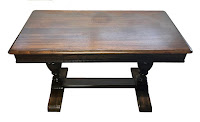 |
| Rocking Chair After |
 |
| Rocking Chair Before |
Needless to say, it was pretty nasty. The springs needed to be re-tied, but were in decent shape, meaning they were not rusted. It's an old chair, I estimate at least 150-175 years old based on the construction and the materials used as well as the design and wood, which was solid mahogany.
I removed the seat and the straw and horsehair, which was quite the job. It was pretty nasty, filled with dirt and who knows what else. Then I worked on the springs, removing all the old ties and webbing that barely held those springs in place. The previous upholsterer used only nails to secure the spring ties so it took several hours to remove all the nails that were imbedded into the chair's seat. After everything was removed, I gave it a thorough cleaning so Jim could work on refreshing the stain. First he gave it a good cleaning and the water was black.
All those years of grime showed up in the water. Once it was cleaned and he touched up the stain, the chair looked really good, its natural beauty coming through. There was no damage on any part of this chair, all details were still in tact including the hard-carving on the back panel. The front arm detail was carved into the curve and the feet were ball and claw, a traditional detail commonly used in the nineteenth century.
Once the chair was cleaned up, secured new webbing to the underside of the chair and I attached the springs securely with waxed thread to the webbing. Then I re-tied the springs using the eight-way tie method which is the proper way to tied springs for upholstery. Next step was attaching the burlap over the springs to hold them securely in place. A layer of Dacron was positioned over the burlap, building up the "crown" of the seat. Two layers of raw cotton were the next step before the final step of the 1" foam which made a nice crown and gave this chair a soft, comfortable sitting area. The original chair was very flat, without much stuffing, therefore it was hard and not very comfortable. With the new padding, it was quite soft and easy to sit on.
The final feature was a leather panel which was sewn by using four 13" section, stitched together in the center then I added an accent top stitch on each side of the seams for a decorative finish. The bronze tacks created a nice contrast to finish off the chair. This was not one of my easier projects, but definitely one of the most rewarding finished products.


























